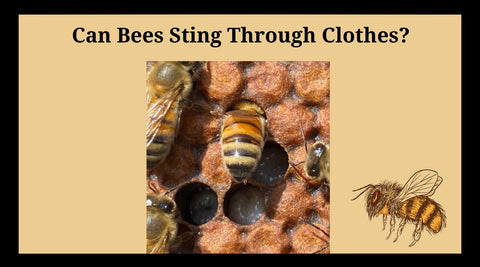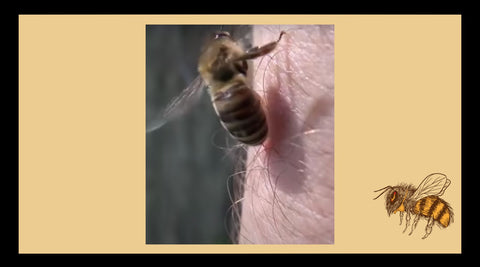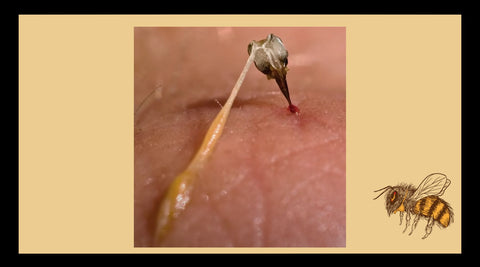Yes, bees can sting through clothes. However, honeybees are usually docile in nature. There's no reason to be afraid of honeybees unless you are near the bee hive.
Be careful not to annoy or disrupt any beehive because you will could possibly get stung regardless if you are wearing protective clothing or not.
You don't have to worry about getting stung by bees at night time, unless you're messing with the honeybee hive.
Read more about honeybee nighttime behavior here: Where do honeybees go at night?
If you're planning to enter an active beehive or spending time around stinging insects like yellow jackets or wasps. You will want to protect yourself with a proper beekeeping suit.
Read our list of Top 10 Best Beekeeping Suits: Avoid Getting Stung in 2023
How Bees Sting Through Clothing
Bees can sting through clothing with minimal effort. If their stinger makes contact with a surface such as clothing, it will pull itself closer and closer (in the case of clothing) or deeper and deeper (in the case of skin) until the required damage is done.

This happens because the bee’s stinger has serrated blades that latch onto its target. Once they latch in, the barbs saw their way deeper and deeper.
If it catches your shirt, it will slowly dig itself further and further down until it touches your bare skin (if your shirt is thin enough).
Of course, once it hits your skin, the bee’s stinger will keep digging until it can’t go any deeper. That’s about the same time you are going to get injected by the bee’s venomous payload.
👉👉 Check out our Beginner BeeKeeping Book here 👈👈
Types of Material Bees Sting Through
- Leather
- Polyester or Rubber
- Cotton or Cotton/Polyester Blend
- Nylon
Leather
Leather is a common pick among beekeepers because it is thick and protective clothing. But it's not perfect.
Sometimes bees can sting right through leather, especially if it's stretched too thin across your hands.
Polyester or Rubber
Not nearly as effective as leather, polyester or rubber aren't the best picks for beekeeping.
We mainly dislike polyester and rubber because of the lack of dexterity they provide compared to better alternatives.
Cotton or Cotton/Polyester Blend
Bees can absolutely sting through cotton or cotton/polyester blend. If you are wearing these as regular clothing, you are bound to get stung.
However, beekeeping suits are ironically made of cotton but they are much more loose-fitting and are made of multiple layers.
Clothes That Prevent Beestings
You don’t a beekeeper’s suit to prevent beestings (although it helps). Heavy fabrics can serve as protective clothing that can be thick enough to prevent the stinger from reaching your exposed skin.
Baggier clothing is going to be safer than tight-fitting clothing for the reasons we explained above. You need to put enough space between your skin and the bee’s blade.
If you know you will be around bees, then you want to avoid materials like nylon that, despite being comfortable, most likely pull tight enough to your body for you to get stung.
Remember, bees can and will sting you anywhere. They don’t care.
This is mostly a problem for people who deal with large amounts of bees (like beekeepers) but again, if you are going to be around a hive, then go ahead and cover your body with thick clothing… including your head!
You can also accidentally step on a bee’s stinger if you are so unfortunate. Make sure you wear socks and shoes, and at the very least, sandals if you are walking around any dead bees.
What Happens When A Honey Bee Stings You and What To Do After
When a honey bee stings you it injects you with its venom which directly affects your immune system and skin cells. This is the reason you feel pain and irritation, and for some people, this can be life-threatening if they are allergic to bees stings.
It’s also life-threatening to the bee. Stinging you often means they pay the ultimate price for their queen because when they sting you (and other mammals), their stinger will dislodge from its abdomen.
Most people react violently to the pain and try to swipe the bee immediately off their skin. Often times this will just kill the bee and get the stinger stuck in your skin.
If you give the bee the opportunity, it can sometimes remove its stingers from your skin and leave the scene of the crime with its organs intact.
This is much easier said than done. That can be very painful but it is possible.
Check these pictures of honey bees to see a sting in action:

And here is a stinger that got stuck in the skin:

Keep in mind, honey bees are not aggressive bugs, they are defensive. They aren’t going to attack you for any old reason but only if they feel you are threatening them or their hive.
How To Heal The Sting
If you get stung by a bee, there are a couple of things should do to ease the pain. Do the following to get rid of the pain as soon as possible:
- Remove the stinger as soon as possible
- Wash the area with soap and water
- Apply a cold compress
You can also try the age-old technique of applying baking soda. We did this every time we got stung when we were younger and it always seemed to do the trick.
FAQs
Can a bee sting through jeans?
A bee can sting through jeans however if they are thick enough jeans the stinger might not reach your skin. The length of a bee stinger is 1.62 ± 0.18 mm [footnote].
If the jeans are any less thick than that and especially tight to your skin, you will get stung by a bee. If you are planning on beekeeping, then we recommend you get a proper suit.
Why Do Bees Sting?
We've covered this extensively in our article, 'Why Do Bees Sting?' Check it out to learn more about bee stings.
What Do Beekeepers Wear?
Beekeepers wear what is known as a beekeeping suit. Often these are those large white astronaut-type suits everyone is familiar with seeing and go a long way for preventing bee stings.
Most beekeepers wear jackets that offer protection using a fencing veil or a round veil attached to the jacket with an elastic waist to keep bees out. The best beekeeping suits are ventilated bee suits.
Bee suits are reserved for professionals and people who are actively working in and around an active bee hive. Some people may be interested in hornet or wasp protection, most of the higher quality bee suits will work for other stinging insects.
There is usually no need for normal people to have bee suits so you don't need to worry about buying one unless you just want to wear a bee suit.
Do Beekeepers Get Stung Through Their Protective Gear?
Yes, beekeepers get strung through their protective gear (known as the bee suit). Just like regular clothing, the baggier the clothing the better.
On top of that, most beekeepers are somewhat used to the pain of getting stung by a bee. Just because they might wear jeans or other regular garments, doesn't mean you should (unless of course, you aren't afraid of getting stung).
👉👉 Check out our Beginner BeeKeeping Book here 👈👈
How Many Bee Stings Are Dangerous?
According to [link], the average person can survive ten stingers per pound of bodyweight.
So if you weight 180 lbs, you can theoretically survive 1800 stings. However, this is not advisable. A child can survive about half that amount.
If you are allergic, you can die from just one bee sting. Take the proper precautions to avoid any bee stings.
Note: there is a difference between honey bees and wasps so be sure to handle them accordingly.
Thanks for bowtiedfarmer.com!
Remember Bee stings can pierce through clothing so always be careful handling them.
Can a Yellow Jacket sting through clothes?
Yes, yellow jackets can sting through clothes. Double layer thick clothing, with a good bee suit is the only sure protection from yellow jacket stings.
Can a wasp sting through clothes?
Yes, a wasp can sting through clothes. Double layer thick clothing, with a good bee suit is the only sure protection from yellow jacket stings.
Can Hornet sting through clothes?
Yes, a hornet can sting through clothes. Double layer thick clothing, with a good bee suit is the only sure protection from yellow jacket stings.
